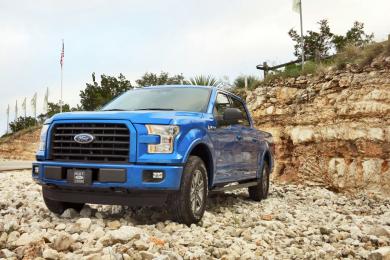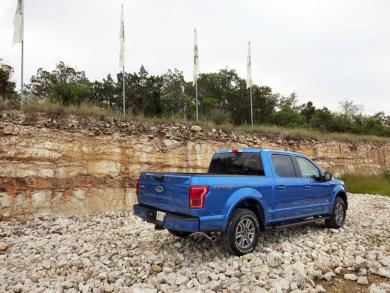If Ford’s sales success with the F‑150 continues with the 2015 model, the Man of Steel just might have to change his name. You see, Supes, there’s a new hero in town, and it’s made entirely out of aluminum. Well, maybe not entirely – Ford’s kept a steel frame underneath the completely redesigned 2015 Ford F‑150 – but in a world where aluminum is more often associated with sports cars and Land Rovers, the decision to use it in the world’s bestselling full-size pickup made waves amongst customers more used to an upward climb on the scale rather than weight reduction program.
Aluminum might be the biggest story surrounding the release of the all-new F‑150 but it’s not the only one, as I discovered during my time behind the wheel of the vehicle in the heart of southern Texas. Just as ripples in a pond slowly expand outwards from the centre of a splash, so too has Ford’s F‑150 belt-tightening opened up new and cascading possibilities for the class-leading truck.
Thinner, Happier, More Productive
A quick primer on how truck builders like Ford determine how much a pickup can tow and haul. Every vehicle has something called a ‘gross vehicle weight rating’, or GVWR, which represents the maximum safe mass that it can carry. Typically, trailer ratings and bed capacity are determined by subtracting the weight of the vehicle, fuel, and at least one passenger (the driver) from the GVWR, with the amount left over translating into the tongue weight that truck’s trailer hitch can bear, or the amount of gear you can stash in the box.
Ford has boosted the maximum tow rating for the 2015 F‑150 to a respectable 5,533 kilos, and payload capacity has similarly climbed to 1,442 kilos – despite the fact that its most powerful engine hasn’t seen any increase in output. The secret is in part the lighter platform: by shaving as much as 320 kilograms off of certain F‑150 models, Ford has been able to better utilize its GVWR for practical purposes rather than simply moving a heavy steel body around. Braking has also been significantly improved for the truck, which in turn has boosted its ability to safely haul a load. Incidentally, although the number hasn’t been SAE certified, the Blue Oval is claiming best-in-class towing for the new F‑150.
  2015 Ford F‑150. Click image to enlarge |
Quicker, Too
As might be expected, a lighter body also means more potent performance from each of the 2015 Ford F‑150’s available engines. The base engine for the truck now displaces 3.5 L, which is a slight drop in size compared to the 2014 edition, and although it produces almost 20 fewer ponies in comparison (282 horsepower and 255 lb-ft of torque altogether), Ford says there is no loss of utility or driving character thanks to the reduced heft of the truck. I wasn’t able to verify that myself, but I was able to drive each of the remaining engine options in the F‑150 stable, which included carryover versions of the 3.5L twin-turbo EcoBoost V6 (365 horsepower and 420 lb-ft of torque) and 5.0L V8 (385 hp and 387 lb-ft of torque), as hp as an all-new 2.7L EcoBoost V6.
The latter represents the first F‑150 engine to have been designed from the outset to be a an EcoBoost unit, and the twin-turbo mill features a unique integrated manifold system along with far higher pressures than are found with the 3.5L EcoBoost V6. Ford has tuned the 2.7L to produce 325 hp and 375 lb-ft of torque, and it has been tagged to tow up to 3,855 kilograms.














